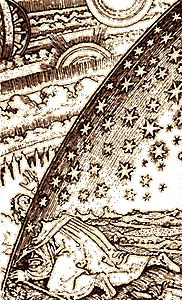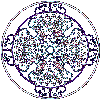
THE WORLD MADE VISIBLE
 Despite our increasing dependance on tools which gather information unseen to the
naked eye, visuals are still important vehicles of knowledge, especially
diagrams, models, and maps which describe what we cannot otherwise see. These
visuals are metaphors which follow (often poetic) conventions of communication.
Images also played an important role in curiosity cabinets, representing aspects
of the natural world impossible to contain within a room as well as standing as
the finest examples of human artifice. Images play even more varied roles today,
and the means by which they are created range from those familiar in the
sixteenth century, such as pen-and-ink, to modern photographic and computer
technologies.
Despite our increasing dependance on tools which gather information unseen to the
naked eye, visuals are still important vehicles of knowledge, especially
diagrams, models, and maps which describe what we cannot otherwise see. These
visuals are metaphors which follow (often poetic) conventions of communication.
Images also played an important role in curiosity cabinets, representing aspects
of the natural world impossible to contain within a room as well as standing as
the finest examples of human artifice. Images play even more varied roles today,
and the means by which they are created range from those familiar in the
sixteenth century, such as pen-and-ink, to modern photographic and computer
technologies.
Because images are so overwhelmingly abundant now, and because we spend so much
time looking at them, there's a temptation to believe that all visible things may
be reduced to images on a computer screen with no loss of information. This
exhibition demonstrates that this is not so.
 Moreover, "hard-copy" images, whether in books or on walls, convey data and
fulfill many different functions beyond those available on video screens.
Nonetheless, many of the categories of images, such as maps, may be just as much
at home in both formats, or even created in one and produced in another.
Even the category of "art"--one of the most privileged of categories of images in
the sixteenth century and in the present day--increasingly crosses the boundaries
between physical object and electronic image.
Moreover, "hard-copy" images, whether in books or on walls, convey data and
fulfill many different functions beyond those available on video screens.
Nonetheless, many of the categories of images, such as maps, may be just as much
at home in both formats, or even created in one and produced in another.
Even the category of "art"--one of the most privileged of categories of images in
the sixteenth century and in the present day--increasingly crosses the boundaries
between physical object and electronic image.
In this section we included items such as maps from the Geography department,
computer-generated xeroxes, an etching by the English artist William Hogarth, a
color lithograph from the Institute for Theoretical Physics, a wall panel from a
series documenting Albert Einstein's life (which decorated the lounge of the
Institute for Theoretical Physics, Rhorshach and Szond IQ tests from Psychology,
and a Chicano poster from the California Ethnic and Multicultural Archives.
 |
{Essays} {Gallery} {Microcosms} |
 |